Affiliate disclosure: This post may contain affiliate links. Please see our Privacy Policy.
You don’t often think of grandma’s hosta patch as the best place to harvest lunch, but hostas are edible (and delicious). Perhaps it’s time to open your eyes to all the wonderful edibles lurking in your very own yard!
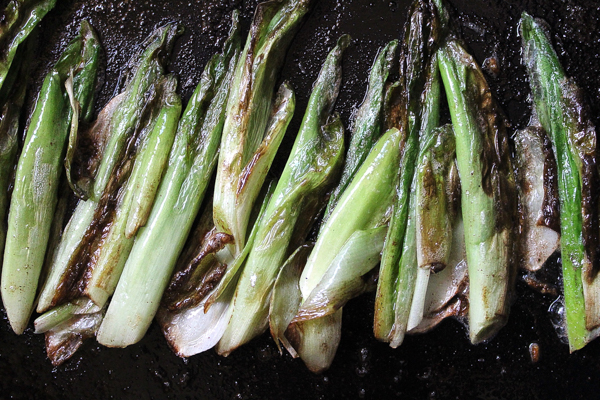
Foraging doesn’t have to mean traveling to a wilderness area, sometimes “wild” edibles are right out your back door.
There are dozens of edibles lurking in the average suburban yard. Some of them are wild, like dandelions, and others are cultivated plants that happen to be tasty edibles.
Hostas happen to be both…they’re a plant that was once harvested as a tasty woodland edible, that became a cultivated plant in our backyards. Somewhere in the process, the edible part was lost in translation, but that doesn’t mean they’re not still delicious!
Long before hostas were planted in shady corners of suburban backyards, they were a wild plant in Japanese woodlands. In Japan, hostas are known as Urui, and they’re part of a class of vegetables known as “Sansai” or “mountain vegetables” which describe wild edibles that are commonly harvested and eaten.
Hostas are no different than any other wild-foraged spring edible, similar to fiddlehead ferns, wild ramps, or morels. Those wild edibles are starting to be cultivated for markets in the US, and you can in fact plant and grow ramps right in your backyard. Though they’re beautiful, we’re not likely to forget they’re also tasty in the process.
Somehow though, when hostas made the transition from wild woodland plant to backyard ornamental, people forgot about eating them. Perhaps because they crossed an ocean to get here, but whatever the reason, it doesn’t mean they’re any less tasty.
In our yard, hostas are essentially a wild edible. They live completely untended at the edge of our woods and under our fruit trees, thriving in shady woodland conditions that aren’t too different from their native land.
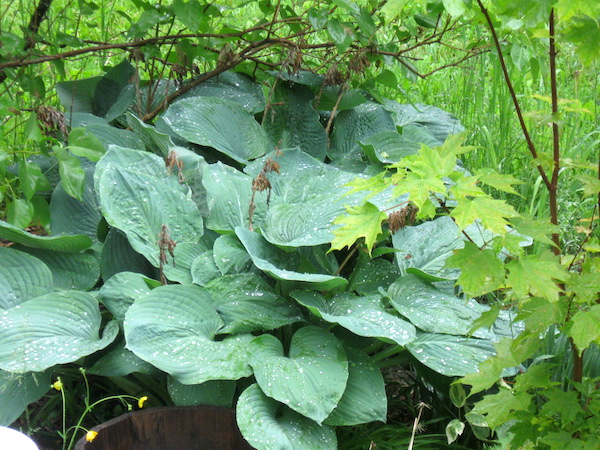
Just like any plant, the taste will vary a bit from variety to variety. The hostas in my yard taste a bit like a cross between a scallion and asparagus. There’s a slight hint of onion, but the overwhelming flavor is the green goodness of asparagus.
They have a pleasant crunch, a bit like the juicy green mouthfeel of iceberg lettuce, but with a lot more flavor. The best time to harvest hostas is when they’re young shoots just emerging from the earth in spring. I’ve heard the flowers are also delicious later on in the summer, and you can eat those without cutting into your actual plant, which may be a better choice if you’re actually harvesting grandma’s patch.
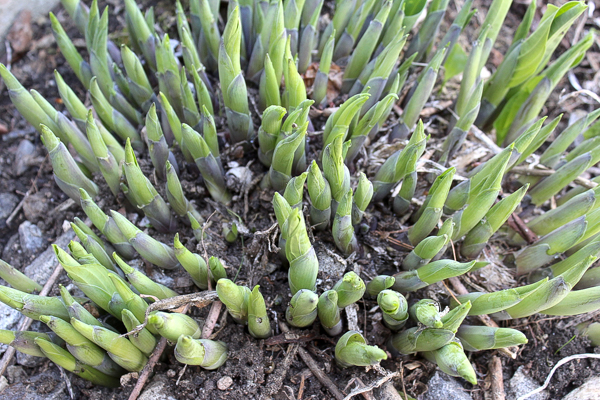
Use a sharp knife to slice hosta shoots off at ground level. The size of the shoots will vary from plant to plant. Obviously larger hosta varieties mean larger shoots, and these in my yard are a giant blue hosta variety that gets really tall by the late spring.
The shoots are likewise pretty large, meaning there’s more to eat. Since this one’s in desperate need of being thinned, it’s no big deal to harvest a few shoots.
Take off a handful or two from each plant and there will be more space for the remaining stalks to thrive.
Giant hosta varieties will be a bit taller and have a lot more girth. Mini hosta varieties may be much smaller.
Regardless of the variety, choose shoots that are tightly coiled and haven’t opened their leaves. Mine made it to about 6 inches high before they started unfurling their leaves.
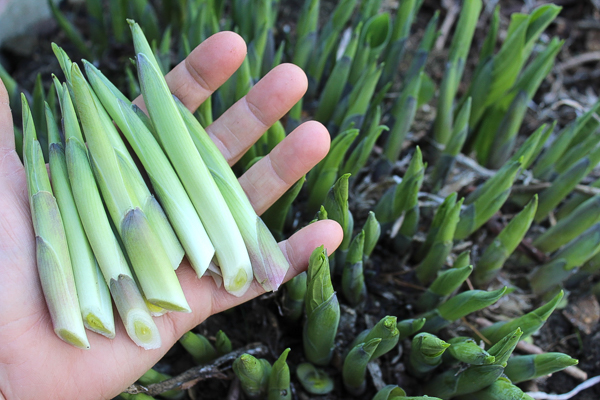
The inside of a hosta shoot looks a lot like a leek, and mine had a bit of leek or scallion flavor. Give them a quick bite raw, and that’ll give you an idea of how your hosta variety will taste cooked. Since mine tasted like asparagus and scallions, I decided to give them a quick pan fry in a little butter.
I’m thinking they’d also be lovely in a spring vegetable tart, or a quiche.
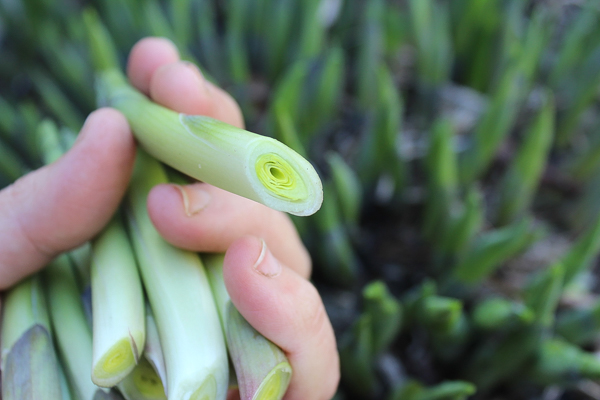
The outside of the hosta shoot is caramelized like an onion, which shows you that they have a good bit of sweetness. The total cook time was only about 2 minutes in a hot pan, and if I had to do it again I’d give them even less time so they maintain more of a crunch.
The flavor was amazing, and though I do love asparagus, I’d have to give the win to hostas.
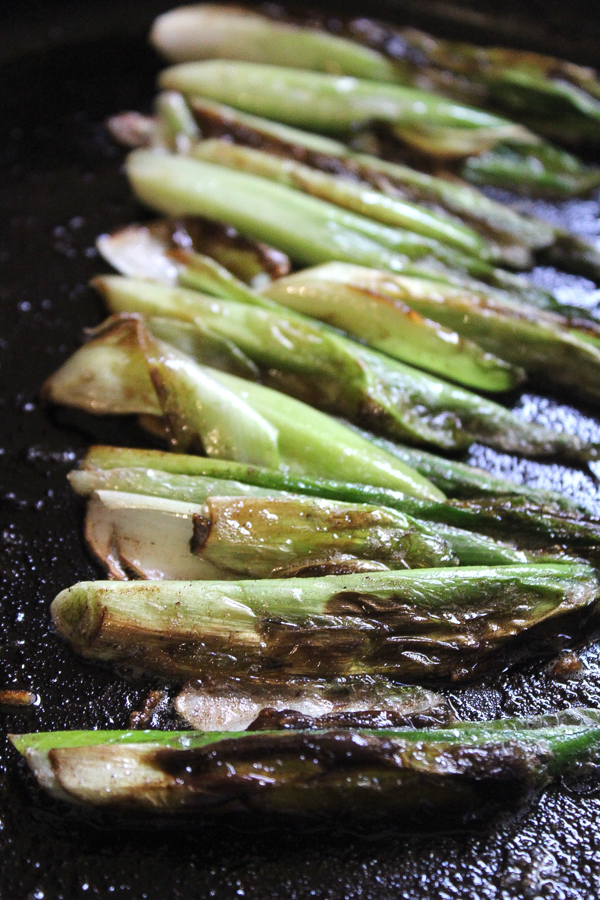
Hosta Blossoms
Beyond the shoots, which are a tasty spring vegetable, the blooms later in the summer are also edible. If you’re worried about harming your prize backyard hostas by harvesting the shoots, just be patient and wait until later in the summer when they bloom.
You can pluck off hosta blossoms without any cutting, which is a better option for young plants that are just getting established. Hosta blossoms taste sweet and floral, a bit like daylily blossoms (which are also a delicious perennial garden edible).
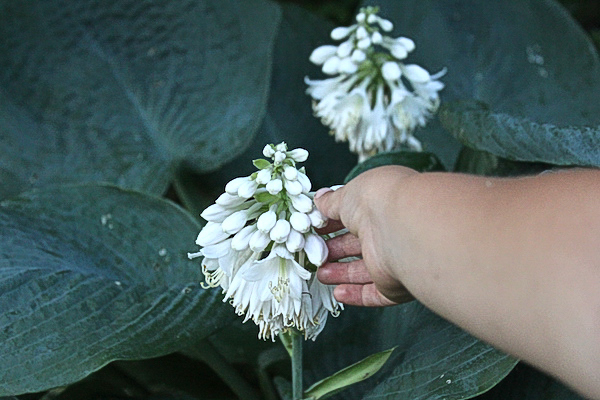
Hosta Nutrition Facts
So if hostas are edible, what nutrients are you getting when you eat them? For the most part, they’re green roughage like lettuce or asparagus with few calories. My Fitness Pal estimates that each leaf has about 2 calories, so they’re not exactly a survival food, but they are high in nutrients.
I did find one scientific study that analyzed the vitamin and mineral content of hostas as a vegetable. The study found that “The leaf K content of 12 hosta plant taxa ranged from 2.85 to 4.05%; the P content from 0.13 to 0.34%; Ca from 0.02 to 1.15%; Mg from 540.00 to 794.12 ppm; Mn 26.93 to 133.77 ppm; Zn 115.39 to 334.52 ppm; Cu 1.78 to 5.95 ppm and Fe 26.43 to 251.95 ppm.”
Where to Buy Hostas
While hostas are a pretty common backyard plant, especially in the Northeast, I’d never heard of them living out west. In New England, most local nurseries will carry them, but they’re often pricey at $15 to $20 for a small hosta in a nursery pot.
But where did the nursery buy that hosta in the first place? They bought them in bulk as bare roots for just a buck or two each. Pot them up and sell them for 10 to 20 times the price and it’s a pretty good rate of return. If you’re looking to plant hostas, buying your own bare roots will save you a bundle.
Generally, bare-root hostas sell for $4 to $8 each online. You can find them on Amazon, but honestly, they can be a bit questionable when it comes to ordering plants. It really depends on the supplier, and sometimes you get luck, sometimes you don’t.
If you want a dependable supplier for hosta plants that consistently delivers quality, I’d suggest ordering from Eden Brothers Nursery. Their price ranges from $4 to $6 a plant, and you can choose spring shipped or fall shipped. I’m particularly fond of giant hostas, especially when it comes to using them as a vegetable. They grow faster and yield better than some of the cute little mini varieties (and they taste spectacular).
Eden Brothers is also a great source for peony roots…and you know that peonies are edible too, right?
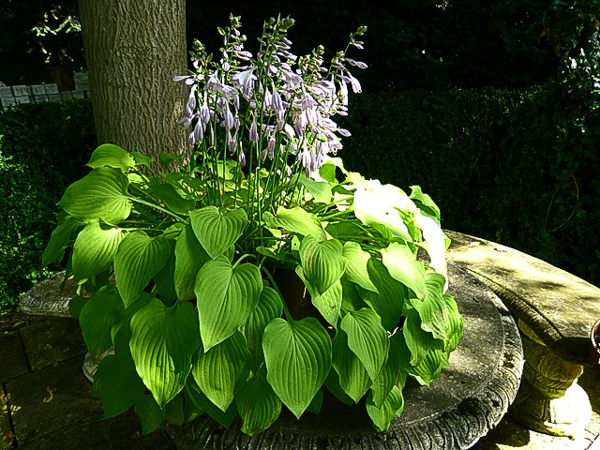
How to Grow Hostas
Once you have hosta bare roots or some successful hosta seed starts, how do you tend them?
In their native Japan, China, and Korea hostas grow in woodlands and along stream banks. It makes sense that they’d grow best in conditions that mimic their natural environment.
That means shade and moist, rich soil with a lot of organic matter. Direct sun can harm hostas, causing the leaves to burn and bleach white.
Plant hostas in part to full shade, ensuring that they’re in shade during the heat of the day. They’re a perennial plant, so they’ll come back year after year in the same spot assuming they’re well-tended.
Protect them from deer and rabbits, which love the tender succulent leaves. Slugs can also be a problem.
In general, hostas are hardy from zone 3 to 8, but this can vary a bit by variety.
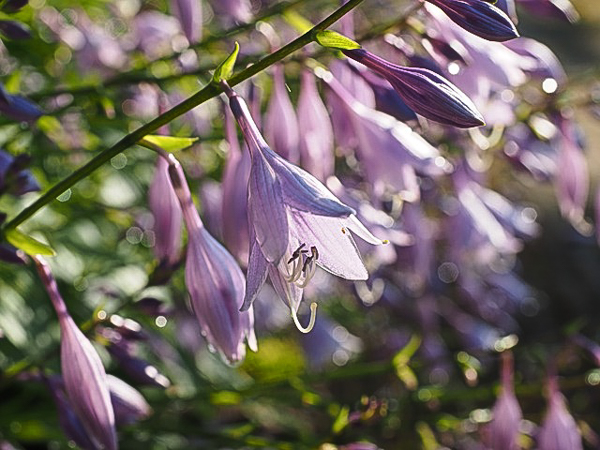
There are a lot of different hosta cultivars, each with different flowers, leaf color, and size. The most common flower colors are purple and white.
Mini hostas stay tiny, somewhere between 6 and 12 inches tall. Giant varieties can grow to 3 feet tall with huge leaves that cover a lot of ground. We have a lot of sprawling woodland space on our homestead, so we grow mostly giant hostas.
Choose varieties that best suit your planting location, saving smaller varieties for near narrow walkways and inter-planting with other shade perennials. Be aware that hostas with green leaves (as opposed to variegated or striped varieties) are generally more dependable in the garden.
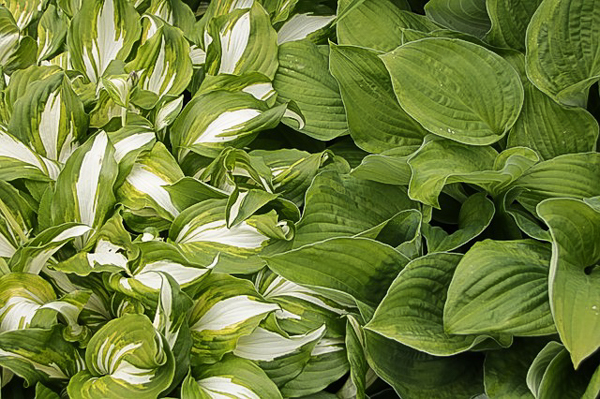
Hosta Recipes
I prepared my hosta shoots rather simply, but if you’re looking for more creative inspiration, try any of these hosta recipes:
- Bacon Wrapped Hosta Shoots
- Hosta Shoots Salad with A Balsamic Reduction
- Pan Seared Hosta Shoots with Ramp Butter
- Hostas with Garlic Mustard Pesto
- Midwestern Vignarola – With Hosta Shoots & Wild Spring Edibles
Wild Foraged Recipes
Looking for more fun backyard garden edibles? Check these out…
- How to Cook a Rose (and other ways to use them)
- How to Make Rose Cordial
- How to Eat a Pine Tree (Every part is edible)
- How to Eat Linden Trees (Every part is edible)
- 16 Medicinal Trees for Your Herbal Medicine Chest
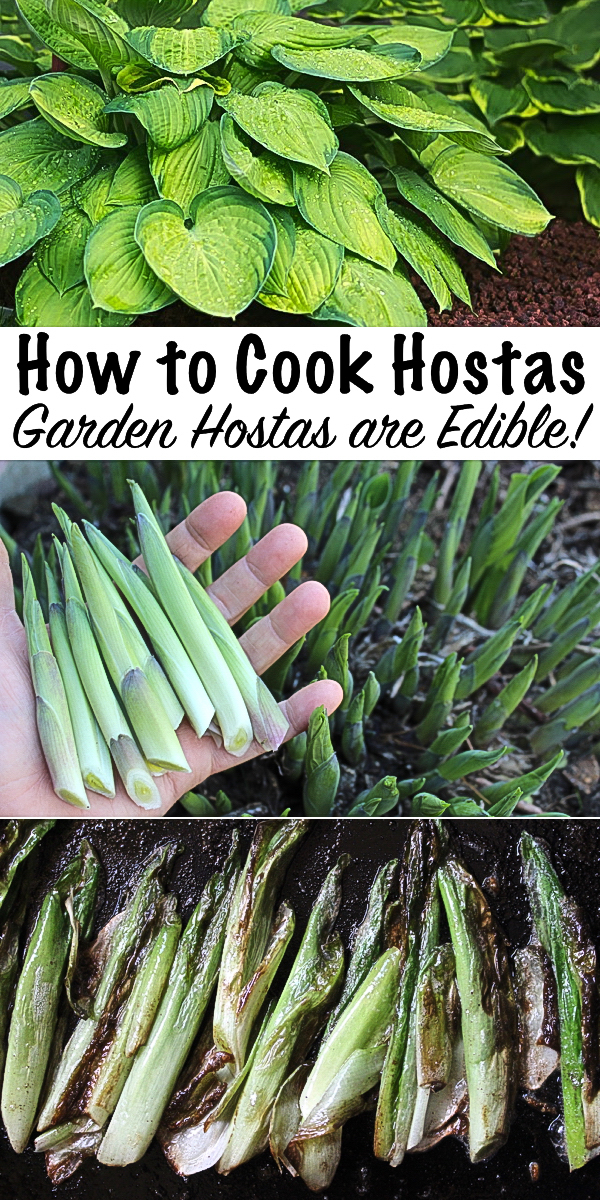














Hi, I just wanted to let you know that I have several varieties of Hosta in my yard and I live in the Southwest (in Utah). I have grown these plants for decades and never had an issue. I’ve even transplanted them when they need to be thinned. Mine are just coming up now, so I was happy to find out they are edible. I’m going to try it because I have always foraged for asparagus, wild spinach, mushrooms and berries. This will be a fun addiiton.
That’s great! Thanks so much for sharing.
Just wondering, I am new here, and fascinated by all of your information! My hubby freaked out this morning when I showed him what I am 98% sure are hostas growing in our front flower beds, and I told him they were edible. He reminded me of the man in Alaska that died in his ‘Magic Bus’ by eating the wrong flower. They made a movie about him. Anyhow, he’s scared for me to try them. Is there some way to be absolutely certain that I am right about this plant before I eat it? I am wanting to try several plants and the medicinal things you post about, but I don’t want to kill myself! Lololol 😂 Thank you 😊 everyone for the information.
The best way to learn identification is from a local person that can come and look at the plant and verify it for you. I also like to look at least 3 reputable resources for identification before eating something. The other tip is to just eat a tiny amount the first time once you have confirmed the identification.
After you check all your references and consult with locals you could try this approach. Nicole Appelian PHD suggested a multii-step approach to safely try a new plant. She said to put the plant in the bend of your elbow for 10 minutes to see if you have a reaction to it. If there is no reaction then hold it to your lip for 10 minutes and see if there is any reaction. Next put it in your mouth, but don’t chew it and wait to see if there is a reaction. Then chew it but don’t swallow it for 10 minutes. Finally swallow it. If you feel any sort of nausea then induce vomiting and drink lots of water. I thought it sounded like a pretty safe approach to exploring unknown plants.
That’s very interesting. Thank you for sharing.
I didn’t see much mention of eating hosta leaves, which is why I would want to grow hostas (to eat the leaves). Could you please confirm the safety of eating raw hosta leaves? Thank you!
Yup, that’s perfectly fine. They’re delicious and you can use them like collards. Enjoy!
Enjoyed your article on Hostas and the joy of eating them. I’ve got various varieties in my front and back gardens. I’ve eyed the shoots every spring, wondering whether they were edible. Now that I know they are, I’ll happily add them to our Chinese and Japanese meals, and fry them in butter just because. My darling Chinese mother-in-law, who is much missed, even after 21 years, would always ask “Can you eat it?” whenever I added a plant to our garden, or we were out and about and came across an interesting plant. If I’d known, we could have cooked the hostas together. I’ll share this news with my sister-in-law, brother-in-law, and daughter and son too. Thanks so much! I’m glad I’ve subscribed to your blog, it’s brilliant!
Thank you for sharing that wonderful story about your mother-in-law. We’re so glad that you are enjoying the blog.
I love how your posts are not only practical but so informative! I cannot believe we’ve had hostas for the last 15 years & I just now learned I could eat them. Better late than never? Ours are still just popping up so I cut a handful & cooked them in coconut oil & OH MY GOODNESS… where have these been all my life?! (Right outside the front windows LOL) They’re incredible! Thank you so much for sharing!
Lol. That’s so funny. We learn something new every day don’t we? I am so glad you are enjoying your hostas. You’re welcome!
Absolutely! Those rare days when I’m not learning anything new are so boring.
Thoroughly enjoying your blog, thank you! 🙂
You mentioned ramps. Very hard to find and very expensive. But delicious!
For those folks who would like a few hosta plants – check with family members and neighbors. Hostas are very easy to transplant and start new plants. Other than a shady place, they aren’t too fussy about soil requirements – at least my hosta plant isn’t, it just grows and grows. ext spring I will thin it out by cutting out some shoots and have them for dinner.
Thanks for the tips!
Hello. Do you knowwhat plants are good for cooked and which are good for raw greens throughout the summer? Most greens that can be used in salads seem to be early spring only. I live in zone 4 if that helps. Tysm.
We use them throughout the summer as a cooked green. The leaves get tougher as the season goes on, but we cook them like kale/collards (we’re also zone 4).
I can hardly wait to try my hostas for dinner tonight. Gotta say, though, they do grow out west quite well. I live near Seattle and have several varieties that thrive in my garden
Deer munched ours totally down one year. I guess they knew what they were doing! Now they are going to have competition LOL
I can’t wait to try this next year. I love asparagus so if it’s anything like that I’m sure they’ll be great!
Another way to get hostas for your own garden, is put the word out you would like some. Around here, in ,Ohio, there is always somebody who is thinning out their hosta beds and are always happy to give the extra away to someone who wants them. This helps both people and it just costs your time.